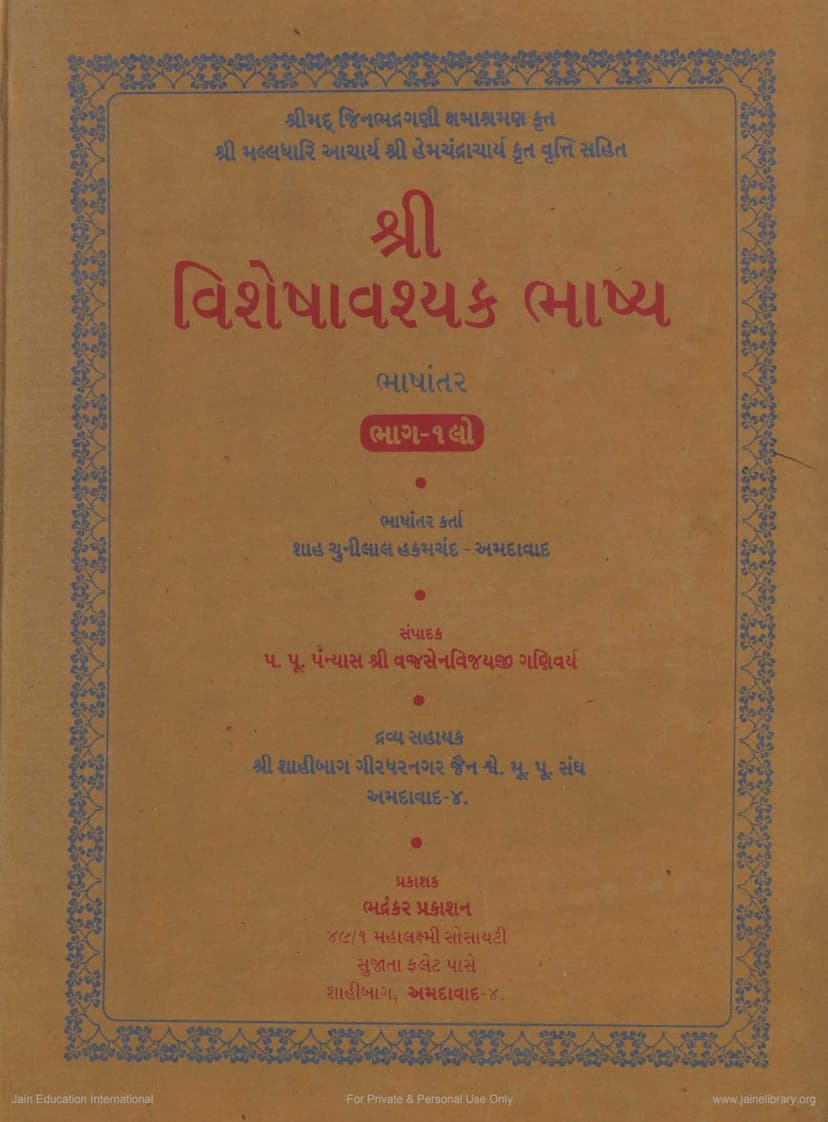Visheshavashyaka Bhasya Part 1
Added to library: September 2, 2025

Summary
Here's a comprehensive summary of the Jain text "Visheshavashyaka Bhasya Part 1," based on the provided pages:
Book Title: Visheshavashyaka Bhasya Part 1 Author: Hemchandracharya, Vajrasenvijay Publisher: Bhadrankar Prakashan
This book is a Gujarati translation and commentary of the original Jain text "Visheshavashyaka Bhasya," authored by Acharya Jinbhadra Kshamashraman and commented upon by Acharya Hemchandracharya (Maladhari). The translation is by the late Shah Chunilal Hakimchand, and the editing is done by Muni Sri Vajrasenvijayji Ganivarya.
Core Subject and Significance:
The "Visheshavashyaka Bhasya" is a highly significant Jain scripture that provides detailed commentary on the "Avashyaka Sutra," a fundamental text for Jain monks and nuns, outlining their essential daily duties and practices. This Bhasya, particularly the part covered in this volume (covering approximately verses 1 to 1548), is valued for its rigorous logic, philosophical insights, and detailed explanations of various Jain concepts. It aims to guide aspiring souls ("mumukshu") towards spiritual liberation by clarifying the principles of Jain philosophy through intricate arguments and reasoning.
Key Themes and Content (as indicated by the summary and index):
The initial pages (1-4) are dedicated to acknowledgments, introductions, and salutations to the lineage of esteemed Jain acharyas who contributed to this work and its dissemination. The "Sampadkiya" (Editorial) section (Page 5) by Sri Vajrasen Vijayji highlights the profound importance of the "Visheshavashyaka Bhasya" and expresses gratitude for the support received for its republication.
The "Prakashkiya" (Publisher's Note) on Page 6 emphasizes the publisher's commitment to making important Jain scriptures accessible and thanks all those involved in the publication, including the editor and the Sha Shahibaug Girdharnagar Jain Shvetambar Murtipujak Sangh for their financial assistance.
The "Atitni Anumodana" (Appreciation of the Past) section (Pages 7-20) provides a detailed history of the Sha Shahibaug Girdharnagar Jain Shvetambar Murtipujak Sangh in Ahmedabad, outlining its establishment, the construction of its temple, and various significant religious and social activities over the years. This section highlights the organizational efforts and devotion of the community in preserving and propagating Jain teachings.
The main content summary, indicated by the extensive "Anukramanika" (Table of Contents) from page 21 to 170, reveals a vast and detailed exploration of various Jain philosophical and practical aspects. The "Visheshavashyaka Bhasya" delves into:
- Introduction and Methodology: Discussions on the nature of scripture, the importance of studying its essence beyond mere stories, and the methodologies of interpretation.
- Jnan (Knowledge): A significant portion is dedicated to explaining the different types of Jain knowledge:
- Matijñāna (Sense Perception/Knowledge): Detailed analysis of its origination, its nature, and its classification.
- Shruta Jñāna (Scriptural Knowledge): Extensive discussion on its relationship with Matijñāna, its various forms (like language, letters, concepts), and its importance.
- Avadhijñāna (Occult Perception): Explanation of its nature, scope, limitations, and the conditions for its attainment, including its relation to physical forms, time, and karma.
- Manahparyaya Jñāna (Mind-Reading Knowledge): Explanation of its nature, scope, and limitations, focusing on its relation to the mind and its practitioners.
- Kevalajñāna (Omniscience): Described as the ultimate, pure, and complete knowledge.
- Nayas and Nikshepas: The text deeply engages with concepts like Nayavada (the doctrine of perspectives) and Nikshepa (classification), which are crucial for understanding Jain philosophy. These are applied to analyze various subjects, including the concept of "Mangala" (auspiciousness).
- Mangala (Auspiciousness): A detailed philosophical discussion on the concept of Mangala, its purpose, its nature, and the correct way to approach it, distinguishing between true and superficial auspiciousness.
- The Six Essentials (Avashyaka): While the "Visheshavashyaka Bhasya" comments on the entire Avashyaka Sutra, the initial part of the Bhasya, as summarized, focuses heavily on "Samayika" (equanimity or meditative practice), its significance, its attainment, and its connection to other Jain principles like samyak charitra (right conduct).
- Logic and Argumentation: The text is characterized by its rigorous logical structure and philosophical debates, addressing potential objections and presenting clear reasoning to support Jain tenets.
- The Nature of Reality: Through the lens of various concepts, the text aims to clarify the nature of reality, the self (soul), karma, and the path to liberation.
- Historical and Community Context: The publisher's notes and historical sections provide context about the Jain community's efforts in preserving and disseminating these ancient teachings.
Overall Purpose and Approach:
The "Visheshavashyaka Bhasya Part 1" aims to provide a profound and scholarly understanding of the fundamental principles of Jainism. It emphasizes the importance of correct knowledge (samyak jñāna) and right conduct (samyak charitra) as the means to achieve liberation (moksha). The translation into Gujarati makes this complex philosophical text accessible to a wider audience, facilitating personal study and spiritual growth. The comprehensive table of contents suggests an incredibly detailed and systematic approach to analyzing Jain doctrines, covering epistemology, metaphysics, ethics, and the path of spiritual discipline.